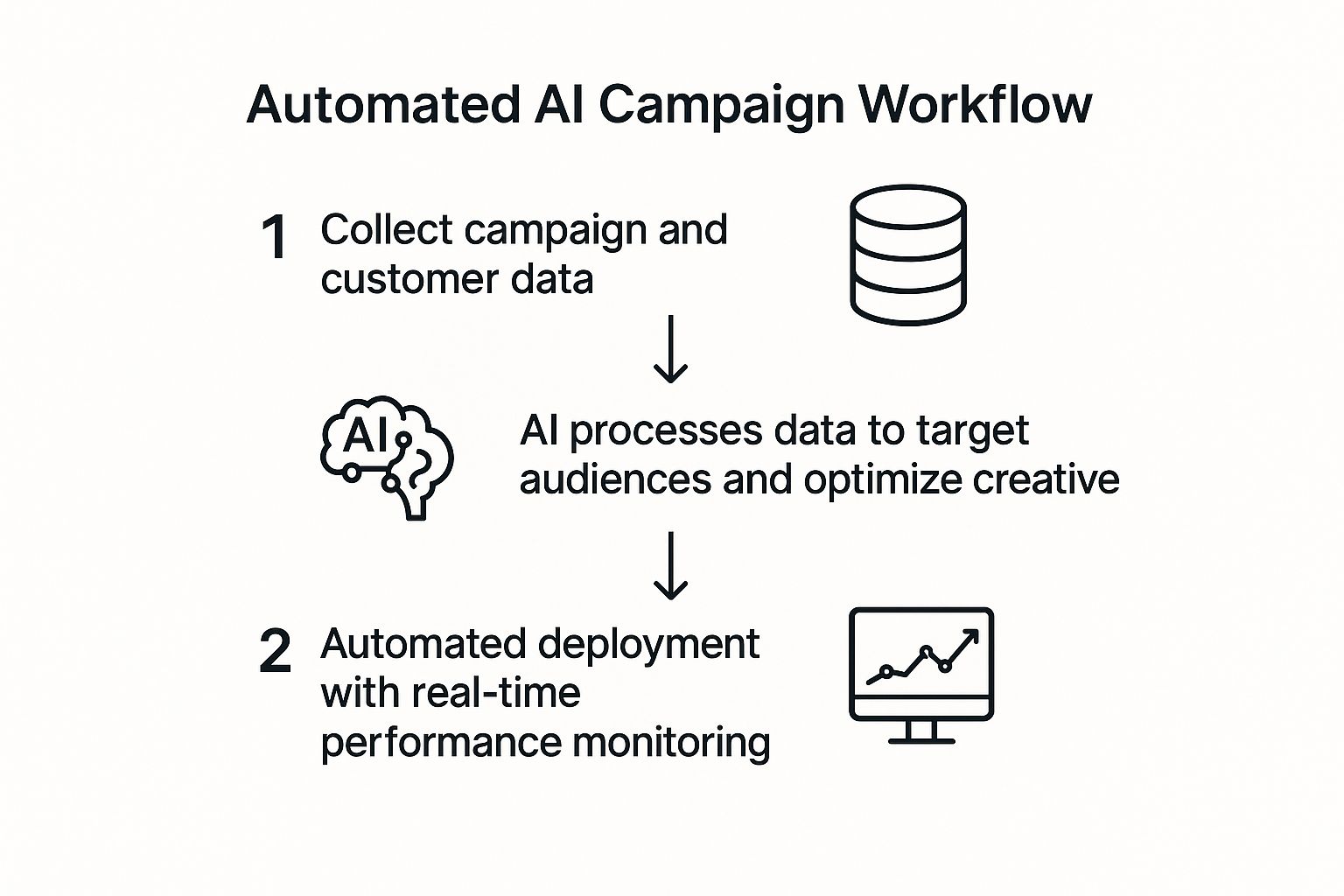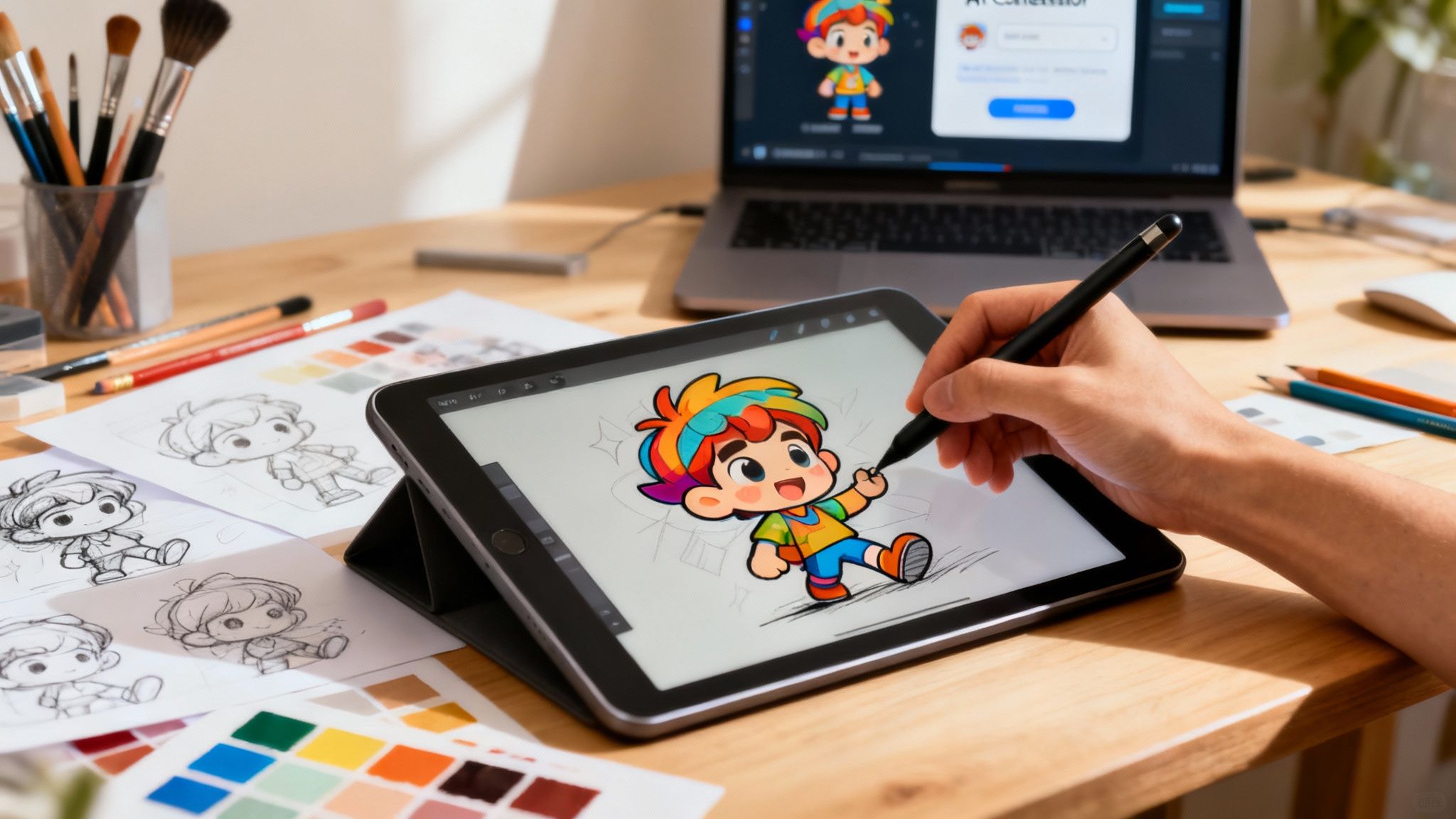
Meta Description: Learn how to use AI for marketing to automate tasks, generate compelling content, and deliver hyper-personalized customer journeys. A practical guide for marketers.
Struggling to keep up with the demand for constant content, data analysis, and personalized campaigns? You're not alone. For today's digital marketers, content creators, and agencies, the pressure to deliver results is relentless. This guide provides the solution, showing you how to use AI for marketing not as a complex, futuristic concept, but as a practical, everyday toolkit. We'll skip the jargon and dive straight into actionable strategies, helping you automate tedious work, supercharge creativity, and make smarter, data-driven decisions that lead to real, measurable growth.
Why AI in Marketing Is No Longer an Option
Feel like you're drowning in the demand for constant, personalized content and data-backed results? You’re not the only one. For digital marketers, creators, and agencies, the daily grind can be absolutely relentless. This is precisely where learning how to use AI for marketing stops being a "nice to have" and becomes a core skill for survival. AI is no longer a far-off concept for giant corporations; it's a real, accessible toolkit that modern marketers can use today to work smarter, not just harder.
The AI marketing space was valued at $12.05 billion in 2020 and is projected to rocket past $107.5 billion by 2028. This reflects a massive shift, with a whopping 88% of marketers now using AI tools. You can dive deeper into these marketing trends. This guide will provide a practical roadmap to help you automate repetitive tasks, supercharge your creativity, and drive measurable growth with campaigns that feel tailor-made for each customer.
Generate Compelling Content with an AI Partner
The secret to leveraging AI for content creation is to stop thinking of it as a replacement for writers and start treating it as a powerful creative partner. For marketers wondering how to use AI for marketing without sounding robotic, the key is collaboration. Instead of one-line prompts, provide a detailed content brief to guide the AI, ensuring the first draft is on-point and aligned with your strategy. This approach helps brainstorm ideas, create drafts, and scale your output effectively.
Real-World Use Case: A Digital Agency's Workflow
Imagine a boutique digital agency managing five clients. Their challenge is creating unique, high-quality blog posts and social media updates for each one, every week. Manually, this is a monumental task.
By creating a detailed content brief for each client, they can use a tool like Media Workbench AI to generate first drafts in minutes. The brief includes:
- Target Audience: "e.g., Early-stage startup founders vs. established B2B marketing managers."
- Core Topic and Angle: "e.g., 'How to secure seed funding' vs. 'Scaling enterprise content strategy.'"
- Key Talking Points: Must-include data points or case studies.
- Tone of Voice: "Witty and informal" vs. "Authoritative and data-driven."
- Keywords: Primary and secondary SEO targets.
With this process, the agency can produce a month's worth of cohesive marketing materials—from blog posts to ad copy—in a single afternoon. The human touch remains vital for editing and adding unique insights, but the heavy lifting is handled, transforming AI from a simple text generator into a scalable content production engine. To get started, explore the best AI content creation tools for this workflow.

Automate Social Media with an Authentic Voice

"Social media automation" often conjures images of robotic, impersonal posts. But modern AI automation isn't about killing your brand's personality; it's about gaining consistency and freeing up your time for genuine engagement. The key is to use AI as a smart assistant, not a replacement for your expertise. AI tools can analyze your account data to pinpoint the best times to post for maximum visibility. More importantly, they can analyze performance to tell you what content formats truly resonate with your audience.
Real-World Use Case: A Content Creator's Strategy
Consider a solo content creator focused on sustainable fashion. They need to post daily across Instagram and TikTok but struggle to keep up while also sourcing products and filming content.
Here’s how they use AI:
- Intelligent Scheduling: An AI tool analyzes their follower activity and schedules posts for peak engagement times, like weekday evenings and weekend afternoons.
- Content Performance Analysis: The AI sifts through metrics and reveals that their "behind-the-scenes" video clips get 30% more engagement than static image posts. This is a clear signal to double down on video.
- Community Management: The AI filters spam comments and suggests replies to common questions like "Where is this jacket from?", freeing the creator to have meaningful conversations with their community.
This system turns raw data into a confident creative strategy. A unified platform like MediaWorkbench.ai is crucial here, allowing the creator to schedule posts, analyze performance, and manage interactions in one place. For more guidance, explore these marketing automation best practices.
👉 Try MediaWorkbench.ai for free – schedule your posts and generate AI content in one place!
Deliver Hyper-Personalized Customer Journeys
Generic, one-size-fits-all marketing campaigns are no longer effective. Customers expect a personal touch, and delivering true personalization at scale is nearly impossible without AI. This is where knowing how to use AI for marketing truly flips the script. AI can analyze vast datasets—browsing history, past purchases, social media activity—to build a detailed profile of each individual. This allows you to move from broad demographic targeting to having one-on-one conversations that resonate and convert.
Real-World Use Case: An E-commerce Brand's Success
An online e-commerce store wants to increase customer lifetime value. Instead of sending a generic "New Arrivals" email blast, they use AI to create a unique experience for every customer.
- Personalized Recommendations: The AI curates a unique set of product recommendations for each person based on what they've recently viewed, abandoned in their cart, or previously purchased. This feels like a helpful service, not spam.
- Dynamic Website Content: The AI dynamically changes the homepage. A visitor who previously bought running shoes sees the latest athletic gear, while a customer who bought hiking boots sees outdoor apparel.
This tailored approach makes every interaction feel relevant, boosting loyalty and sales. The global artificial intelligence market is projected to grow from $391 billion in 2025 to $1.81 trillion by 2030, driven by these real-world wins. For more context, you can explore detailed AI market statistics and their implications. With great power comes great responsibility; always be transparent about data usage to build trust.
Make Smarter Decisions with Predictive Analytics

While standard dashboards show what has happened, predictive analytics reveal what’s likely to happen next. This is the strategic power of AI. Instead of reacting, you can proactively make decisions that drive growth. Predictive analytics uses your historical data and applies machine learning models to spot patterns a human analyst would likely miss. For any marketer asking how to use AI for marketing, this forward-looking capability is a significant competitive advantage.
Real-World Use Case: A SaaS Company's SEO Strategy
A B2B SaaS company needs to stay ahead in a competitive market. As search engines like Google evolve with AI Overviews, visibility depends on demonstrating deep expertise.
Here’s how they use predictive analytics:
- Customer Churn Prediction: An AI model analyzes user behavior and identifies customers at risk of churning 30% earlier than manual analysis, allowing the success team to intervene with targeted support.
- Content Strategy: The AI analyzes emerging industry trends and competitor content, predicting which topics and keyword clusters will gain traction. This helps them create authoritative content that captures search interest early, positioning their brand as a trustworthy source for both humans and AI algorithms.
By anticipating market shifts and customer needs, they aren't just optimizing for today's search engine; they're future-proofing their strategy. To understand the technology behind this, you can explore some machine learning code examples.
Conclusion
Integrating AI into your marketing strategy is no longer a futuristic vision—it's a present-day necessity for growth and efficiency. By leveraging AI as a creative partner for content generation, you can scale your output without sacrificing quality. Automating social media with an intelligent, authentic voice buys back your time for meaningful engagement. Furthermore, using predictive analytics and hyper-personalization allows you to make smarter decisions and build deeper customer relationships. The key is to start with a clear problem and choose tools that solve it effectively. Don't just keep up with the changes; get ahead by making AI a core part of your workflow.
Ready to see how a unified AI platform can streamline your marketing efforts? Explore MediaWorkbench.ai to generate content, schedule posts, and analyze performance all from one dashboard. Try MediaWorkbench.ai for free and start saving hours every day!

